239. Northern Black Korhaan Afrotis afraoides (Witvlerkkorhaan)
ORDER OTIDIFORMES. Family: Otitidae
Description
Length 50 cm, weight 500-952 g, males slightly larger than females. In flight the white primary 'windows' are diagnostic, but on ground difficult to separate from Southern Black Korhaan.
Adult male: Head black, apart from white cheek patch and brown crown, finely barred and edged white. White collar across mantle extends onto sides of upper breast; remainder of upper parts barred buff-brown and black (bars of equal width). Greater, median and outer lesser coverts white, forming conspicuous edge to folded wing; in flight, together with white bases to primaries, form conspicuous bar across wing. Secondaries blackish. Underwing blackish, primaries with prominent white bases. Neck and underparts black. Bill coral-red, with grey tip and pale horn subterminal bar. Eyes brown; eye ring red. Legs bright yellow.
Adult female: As adult male, but head, neck and breast buff-brown, crown and neck barred black. Lacks white mantle collar. Black of underparts confined to belly.
Juvenile: As adult female, but remiges, and back and crown feathers tipped pale. Captive males till in juvenile plumage at 6 mo; black appears on neck at 7 month.
Similar species: Told from Southern Black Korhaan by the primary feather variation. Northern Black Korhaan shows conspicious white flashes in the primaries in flight. In the Southern Black Korhaan the black bars are broader than the brown and, in the Northern Black Korhaan, the buff-brown and black bars are of equal width. Confusion with Southern Black Korhaan only likely in small area of overlap. Red-crested Korhaan differs from female in having black-and-white chevrons on upper parts, duller legs, no white in primaries. Male Black-bellied Bustard has longer neck and legs, black line down foreneck, mottled upper parts, paler legs, and white in wing much more extensive.
Distribution: It is endemic to southern Africa, it is common in Namibia, Botswana and northern South Africa. Overlaps with Southern Black Korhaan at southern end of range.
Habitat
It is mainly found in semi-arid to arid habitat associated with a summer rainfall pattern. It occurs in Nama karoo, Kalahari sandveld, dry sandveld, open savanna and grass-covered dunes. It generally prefers heavily grazed areas with sparse ground cover in the Savanna grasslands where it breeds and feeds.
Diet
Its eating habits are omnivorous, preferring mainly insects such as termites, grasshoppers and beetles, but it also eats plant products, such as seeds. It forages while walking slowly, pecking food from the ground and chasing after insects.
Breeding
Polygynous, territorial solitary nester. Courtship is elaborate, involving multiple females and one male and featuring exaggeratedly undulating flight displays, playful chasing and the male displaying his white breast patches. The male is extremely protective of his 200-300 m2 territory, fighting other males by striking with his wings, after which the other male usually flies off. It does not build a nest, laying its eggs directly on the ground among scattered grass tufts and shrubs, often under small thorn trees. Egg-laying season is year-round, peaking from September-March. It lays 1-3, usually 1-2 eggs, which are incubated solely by the female for 21-23 days. The female cares for the chicks, who can fly when they are only half-grown.
Call
The male utters a raucous, ear-splitting kraaak, kraaak, krraka krraka kraka, kraka from the ground. It has faster notes in display flight.
Listen to Bird Call.
Status
Common and widespread endemic, mostly sedentary and usually solitary.
Africa Wild Bird Book
Northern Black Korhaan Photos
239. Northern Black Korhaan Eupodotis afraoides
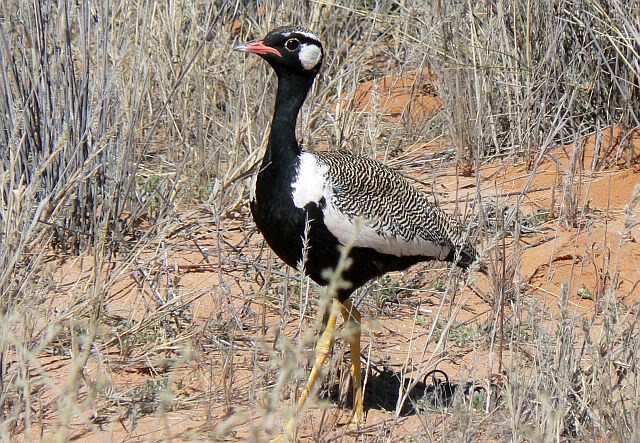 © Toko
© Toko
Male, Kgalagadi Transfrontier Park
 © Duke
© Duke
 © nan
© nan
Female
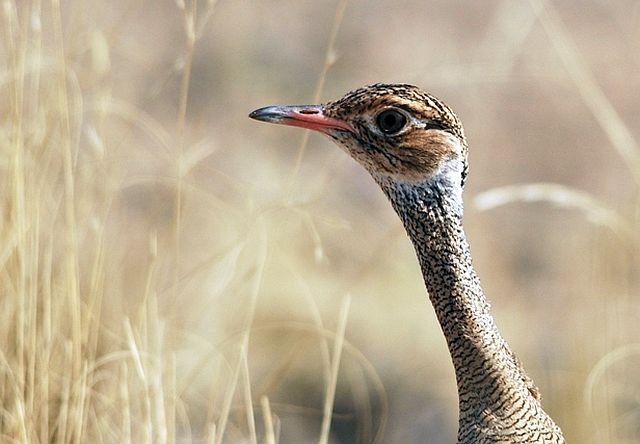 © Mel
© Mel
Female
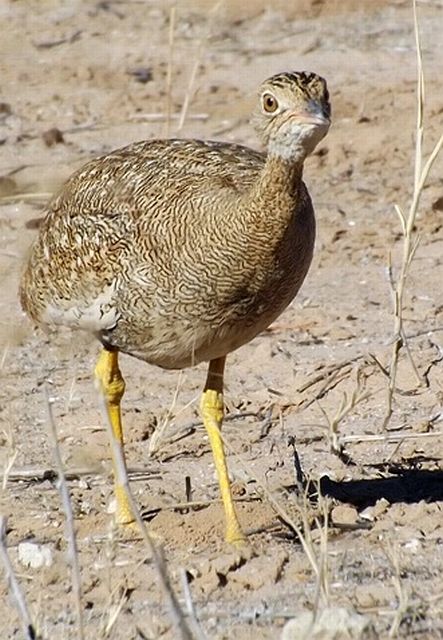 © pooky
© pooky
Female
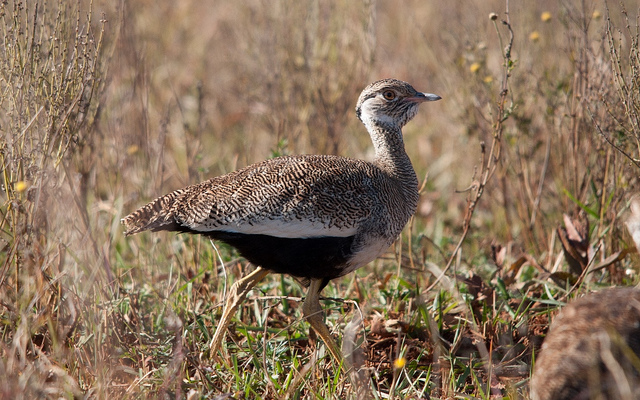 © Joan
© Joan
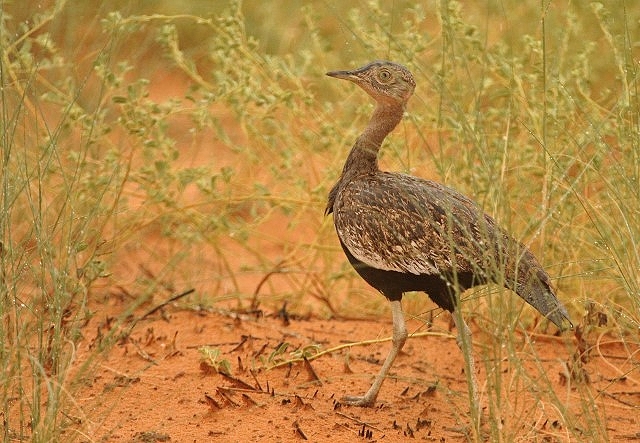 © nan
© nan
Juvenile male
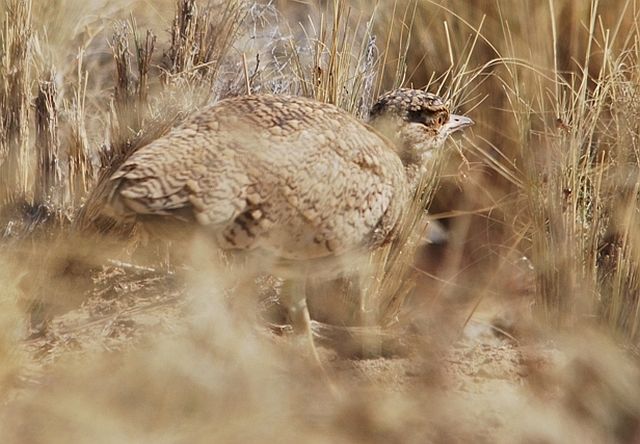 © Mel
© Mel
Juvenile
Links:
http://sabap2.adu.org.za/docs/sabap1/239.pdf
http://sabap2.adu.org.za/spp_summary.ph ... §ion=3]Sabap2[/url]
Ian Sinclair. SASOL VOELS VAN SUIDER AFRICA (3de UIT)
http://www.avianleisure.com/blog/south- ... -korhaans/
http://books.google.de/books?id=dOTi7T8 ... ls&f=false
 © Toko
© TokoMale, Kgalagadi Transfrontier Park
 © Duke
© Duke © nan
© nanFemale
 © Mel
© MelFemale
 © pooky
© pookyFemale
 © Joan
© Joan © nan
© nanJuvenile male
 © Mel
© MelJuvenile
Links:
http://sabap2.adu.org.za/docs/sabap1/239.pdf
http://sabap2.adu.org.za/spp_summary.ph ... §ion=3]Sabap2[/url]
Ian Sinclair. SASOL VOELS VAN SUIDER AFRICA (3de UIT)
http://www.avianleisure.com/blog/south- ... -korhaans/
http://books.google.de/books?id=dOTi7T8 ... ls&f=false
Black-bellied Bustard
238. Black-bellied Bustard Lissotis melanogaster (Langbeenkorhaan)
ORDER OTIDIFORMES. Family: Otididae
Description
Length 58-65 cm. The bill and legs are dull yellow. The back of both sexes is spotted and barred.
Male: Upper parts light brown upperparts with black and brown streaks and spots. Underparts black. Head black, white, and buff. Long, thin light brown neck with a thin black line down the front, which which continues and broadens out to a black breast and belly. Brown and buff tail with four or five narrow dark brown bands. The upper surface of the wings is white with a brown triangle at the base; the flight feathers have black tips except for the outer secondaries. The white of the wings is visible when the bird stands, contrasting with the black underparts.
The female is plain buff cryptically marked with darker brown mottling on the back and vermiculation (narrow wavy bands) on the neck and breast. Whitish below.
Juvenile: Duller and darker, dark grey crown, buff spots on the wing.
Similar species: The long-legged Black-bellied Bustard superficially resembles the Red-crested Korhaan but is much larger, has a very long, thin neck and a diagnostic black line down the centre of the throat.
Distribution
Occurs across sub-Saharan Africa; in southern Africa it is uncommon to locally common in north-eastern Namibia (including the Caprivi Strip), northern Botswana, Zimbabwe, Mozambique and eastern South Africa.
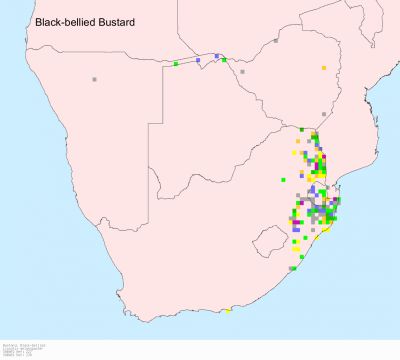
Habitat
It generally prefers tall, dense woodland and grassy savanna as well as cultivated pastures, fields, fallow lands and woodland, such as cluster-leaf (Terminalia), Baikaea plurijaga (Zambezi teak), bushwillows (Combretum), Mopane (Colospermum mopane) and miombo (Brachystegia).
Diet
Its diet is little known in southern Africa, but elsewhere it is omnivorous, mainly feeding on small invertebrates, such as locusts, grasshoppers and beetles, as well as vegetable matter, such as fruit, seeds and leaves.
Breeding
Polygynous, solitary nester, with one male doing an elaborate courtship display to multiple females, whom he mates with afterwards. The male begins with a slow display flight, taking to the air with slow wing beats to make himself appear larger than life, then glides down to the ground with outstretched wings to expose his black belly. Within his territory, the male will also stand on an elevated spot like a termite mound to make himself more visible, stretching his neck to expose the black line running down to his belly and making a croaking call before suddenly pulling his neck against his breast and lets out a characteristic popping sound.The eggs are laid directly on the ground, often among tufts of tall grass. The eggs are well camouflaged with light olive green blotches streaked with brown, olive and grey. Egg-laying season is from about September-March. The female lays 1-2 eggs, which are incubated solely by the female. The chicks are cared for by the mother, who chases away intruders, such as warthog, if they get to close to her young.
Call
Loud frog-like quark, followed by kw-ick (like a cork popping out of a bottle). In courtship display the male retracts his head to his back, giving a short rising wheezy whistle, zhweeeeee, pauses in that position, and slowly raises his head, giving a popping quock or plop followed by soft gurgling.
http://www.xeno-canto.org/species/Lissotis-melanogaster
Status
Uncommon to locally common resident. Classified as Near-threatened on the IUCN Red List.
ORDER OTIDIFORMES. Family: Otididae
Description
Length 58-65 cm. The bill and legs are dull yellow. The back of both sexes is spotted and barred.
Male: Upper parts light brown upperparts with black and brown streaks and spots. Underparts black. Head black, white, and buff. Long, thin light brown neck with a thin black line down the front, which which continues and broadens out to a black breast and belly. Brown and buff tail with four or five narrow dark brown bands. The upper surface of the wings is white with a brown triangle at the base; the flight feathers have black tips except for the outer secondaries. The white of the wings is visible when the bird stands, contrasting with the black underparts.
The female is plain buff cryptically marked with darker brown mottling on the back and vermiculation (narrow wavy bands) on the neck and breast. Whitish below.
Juvenile: Duller and darker, dark grey crown, buff spots on the wing.
Similar species: The long-legged Black-bellied Bustard superficially resembles the Red-crested Korhaan but is much larger, has a very long, thin neck and a diagnostic black line down the centre of the throat.
Distribution
Occurs across sub-Saharan Africa; in southern Africa it is uncommon to locally common in north-eastern Namibia (including the Caprivi Strip), northern Botswana, Zimbabwe, Mozambique and eastern South Africa.

Habitat
It generally prefers tall, dense woodland and grassy savanna as well as cultivated pastures, fields, fallow lands and woodland, such as cluster-leaf (Terminalia), Baikaea plurijaga (Zambezi teak), bushwillows (Combretum), Mopane (Colospermum mopane) and miombo (Brachystegia).
Diet
Its diet is little known in southern Africa, but elsewhere it is omnivorous, mainly feeding on small invertebrates, such as locusts, grasshoppers and beetles, as well as vegetable matter, such as fruit, seeds and leaves.
Breeding
Polygynous, solitary nester, with one male doing an elaborate courtship display to multiple females, whom he mates with afterwards. The male begins with a slow display flight, taking to the air with slow wing beats to make himself appear larger than life, then glides down to the ground with outstretched wings to expose his black belly. Within his territory, the male will also stand on an elevated spot like a termite mound to make himself more visible, stretching his neck to expose the black line running down to his belly and making a croaking call before suddenly pulling his neck against his breast and lets out a characteristic popping sound.The eggs are laid directly on the ground, often among tufts of tall grass. The eggs are well camouflaged with light olive green blotches streaked with brown, olive and grey. Egg-laying season is from about September-March. The female lays 1-2 eggs, which are incubated solely by the female. The chicks are cared for by the mother, who chases away intruders, such as warthog, if they get to close to her young.
Call
Loud frog-like quark, followed by kw-ick (like a cork popping out of a bottle). In courtship display the male retracts his head to his back, giving a short rising wheezy whistle, zhweeeeee, pauses in that position, and slowly raises his head, giving a popping quock or plop followed by soft gurgling.
http://www.xeno-canto.org/species/Lissotis-melanogaster
Status
Uncommon to locally common resident. Classified as Near-threatened on the IUCN Red List.
Black-bellied Bustard Photos
238. Black-bellied Bustard Lissotis melanogaster
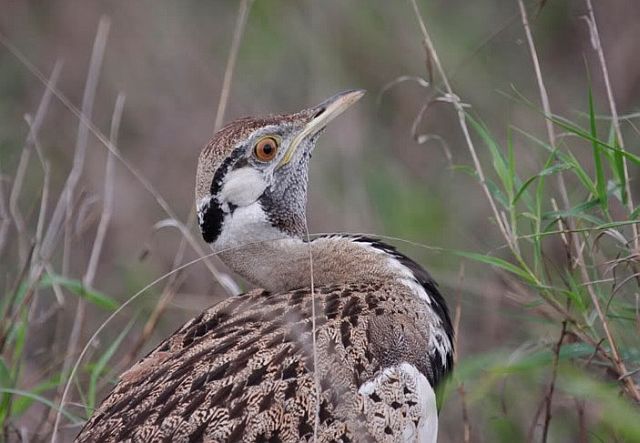 © leachy
© leachy
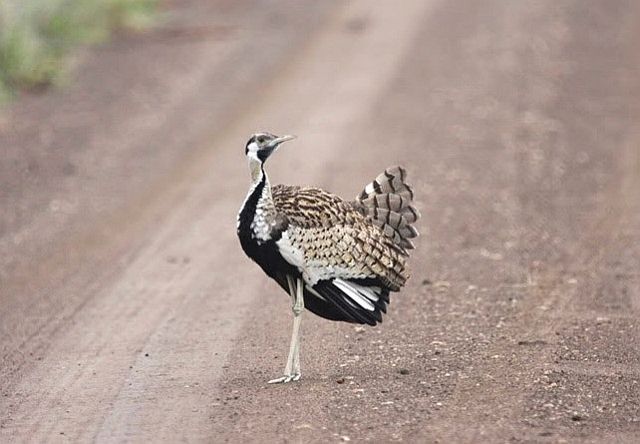 © leachy
© leachy
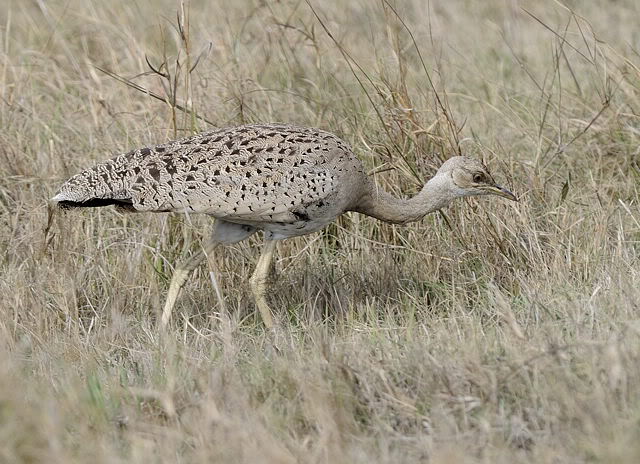 © Dewi
© Dewi
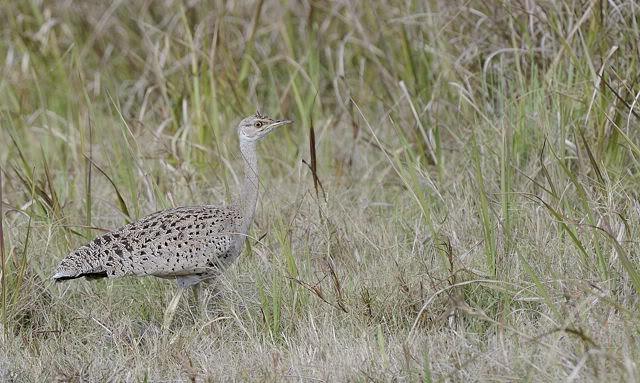 © Dewi
© Dewi
 © Pumbaa
© Pumbaa
Kruger National Park
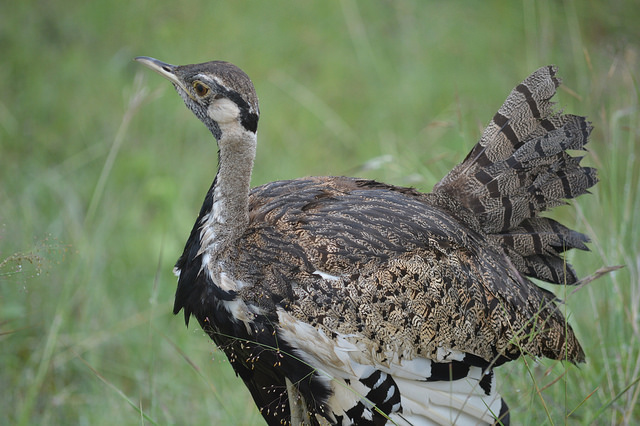 © Twigga
© Twigga
Kruger National Park
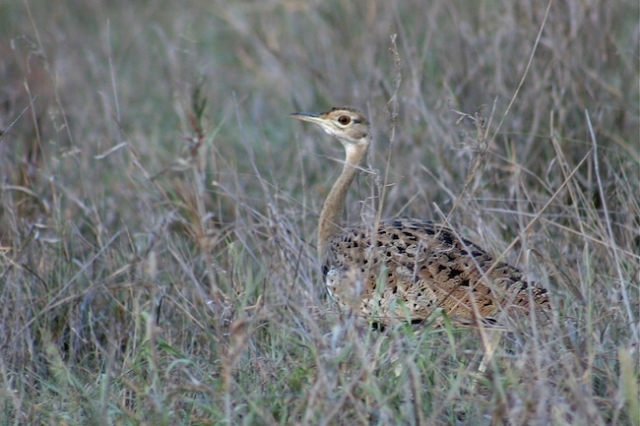 © ExFmem
© ExFmem
Kruger National Park
Links:
http://sabap2.adu.org.za/docs/sabap1/238.pdf
http://sabap2.adu.org.za/species_info.p ... #menu_left
Bustards, in: Trevor Carnaby. Beat about the Bush: Birds
http://www.oiseaux.net/oiseaux/outarde. ... .noir.html
http://www.arkive.org/black-bellied-bus ... anogaster/
 © leachy
© leachy © leachy
© leachy © Dewi
© Dewi © Dewi
© Dewi © Pumbaa
© PumbaaKruger National Park
 © Twigga
© TwiggaKruger National Park
 © ExFmem
© ExFmemKruger National Park
Links:
http://sabap2.adu.org.za/docs/sabap1/238.pdf
http://sabap2.adu.org.za/species_info.p ... #menu_left
Bustards, in: Trevor Carnaby. Beat about the Bush: Birds
http://www.oiseaux.net/oiseaux/outarde. ... .noir.html
http://www.arkive.org/black-bellied-bus ... anogaster/
ORDER GRUIFORMES
ORDER GRUIFORMES
Traditionally, a number of wading and terrestrial bird families that did not seem to belong to any other order were classified together as Gruiformes. But there are only two clades (natural groups) among the birds traditionally classified as Gruiformes. Rails (Rallidae), Flufftails (Sarothruridae), finfoots and sungrebe (Heliornithidae), adzebills (Aptornithidae), trumpeters (Psophiidae), limpkin (Aramidae), and cranes (Gruidae) compose the order Gruiformes and these are the only true Gruiformes.
This order comprises four families in Southern Africa:
Family Heliornithidae (Finfoot)
Family Sarothruridae (Flufftails)
Family Rallidae (Rails, Crakes and Coots)
Family Gruidae (Cranes)
Traditionally, a number of wading and terrestrial bird families that did not seem to belong to any other order were classified together as Gruiformes. But there are only two clades (natural groups) among the birds traditionally classified as Gruiformes. Rails (Rallidae), Flufftails (Sarothruridae), finfoots and sungrebe (Heliornithidae), adzebills (Aptornithidae), trumpeters (Psophiidae), limpkin (Aramidae), and cranes (Gruidae) compose the order Gruiformes and these are the only true Gruiformes.
This order comprises four families in Southern Africa:
Family Heliornithidae (Finfoot)
Family Sarothruridae (Flufftails)
Family Rallidae (Rails, Crakes and Coots)
Family Gruidae (Cranes)
Family Heliornithidae (Finfoot)
The Heliornithidae are a small family of tropical birds with webbed lobes on their feet like those of grebes and coots. The family overall are known as finfoots, although one species is known as a Sungrebe.
The family is composed of three species in three genera. The African Finfoot is found in tropical Africa on streams in woodland. The Masked Finfoot has a scattered distribution from Eastern India down through southeast Asia to the Wallace Line. The Sungrebe is found in tropical Central and South America. Finfoots are highly secretive and many aspects of their biology are unknown to science.
Finfoots resemble rails; they have long necks, slender bodies, broad tails, and sharp, pointed bills. They have a diverse range of calls, but do not call frequently. Their legs and feet are brightly coloured and, unlike grebes, they are capable of walking well and even moving quickly on land.
Finfoots are found in numerous habitats in the tropics as long as there is water and cover. It is uncertain why cover is so essential to finfoots, but they are extremely secretive and often overlooked. Their ranges extend from coastal creeks to fast-moving mountain streams, most commonly being found in large slow moving bodies of water. They also use swamps, reed beds, mangroves, and forest. Finfoots are territorial, probably for much of the year and certainly when breeding. They are not thought to undertake regular migrations, but some birds do regularly disperse and they are quick to colonise new areas of suitable habitat.
Finfoots feed on a wide range of foods, insects of various sorts being the most frequently observed component of their diet. Little quantitative information on finfoot diet exists, but they have also been recorded eating molluscs, crustaceans, spiders, frogs, fish and some leaves and seeds. Unlike grebes they do not dive to obtain food, instead picking prey off the water's surface or foraging on the shore.
All three species tend to breed after the wet season, the exact timing of which is dependent on the local climate. The breeding behaviour of the Masked Finfoot is almost entirely unknown. All three species exhibit some changes in appearance prior to breeding - Masked Finfoots develop a fleshy knob above the bill, and the plumage of the male African Finfoot and female Sungrebe also change. There is considerable variation within the finfoots on several aspects of breeding; in the Sungrebe the nest building and incubation duties are shared between the sexes, in the African Finfoot the female alone incubates. The nests of all finfoots are untidy bowls of sticks, twigs, and reeds suspended in vegetation above water.
There is only one species indigenous to southern Africa:
Family Heliornithidae (Finfoot)
Podica senegalensis African Finfoot 229
The family is composed of three species in three genera. The African Finfoot is found in tropical Africa on streams in woodland. The Masked Finfoot has a scattered distribution from Eastern India down through southeast Asia to the Wallace Line. The Sungrebe is found in tropical Central and South America. Finfoots are highly secretive and many aspects of their biology are unknown to science.
Finfoots resemble rails; they have long necks, slender bodies, broad tails, and sharp, pointed bills. They have a diverse range of calls, but do not call frequently. Their legs and feet are brightly coloured and, unlike grebes, they are capable of walking well and even moving quickly on land.
Finfoots are found in numerous habitats in the tropics as long as there is water and cover. It is uncertain why cover is so essential to finfoots, but they are extremely secretive and often overlooked. Their ranges extend from coastal creeks to fast-moving mountain streams, most commonly being found in large slow moving bodies of water. They also use swamps, reed beds, mangroves, and forest. Finfoots are territorial, probably for much of the year and certainly when breeding. They are not thought to undertake regular migrations, but some birds do regularly disperse and they are quick to colonise new areas of suitable habitat.
Finfoots feed on a wide range of foods, insects of various sorts being the most frequently observed component of their diet. Little quantitative information on finfoot diet exists, but they have also been recorded eating molluscs, crustaceans, spiders, frogs, fish and some leaves and seeds. Unlike grebes they do not dive to obtain food, instead picking prey off the water's surface or foraging on the shore.
All three species tend to breed after the wet season, the exact timing of which is dependent on the local climate. The breeding behaviour of the Masked Finfoot is almost entirely unknown. All three species exhibit some changes in appearance prior to breeding - Masked Finfoots develop a fleshy knob above the bill, and the plumage of the male African Finfoot and female Sungrebe also change. There is considerable variation within the finfoots on several aspects of breeding; in the Sungrebe the nest building and incubation duties are shared between the sexes, in the African Finfoot the female alone incubates. The nests of all finfoots are untidy bowls of sticks, twigs, and reeds suspended in vegetation above water.
There is only one species indigenous to southern Africa:
Family Heliornithidae (Finfoot)
Podica senegalensis African Finfoot 229
African Finfoot
229. African Finfoot Podica senegalensis (Watertrapper)
Order: Gruiformes. Family: Heliornithidae
Description
The breeding male has rather dark upperparts body plumage with pale spangling & slightly paler underparts. The foreneck/hindneck are often contrastingly bicoloured with a thin grey line running from the eye down the side of the neck. The daggerlike bill is bright red, the stiff tail long & dark whilst the legs & feet are bright orange-red.
The female is an altogether paler bird with a red-brown beak, darker hindneck whitish on the lores, chin, throat & foreneck. There is a brown area extending down the neck from behind the eye thickly edged white and the female thus seems to have a more prominent neck/facial pattern.
Immatures resemble females but are much duller in the face/neck.
Similar species: The bright red legs and bill distinguishes it from darter and ducks.
Distribution
Occurs across much of sub-Saharan Africa, from Senegal to western Ethiopia south through the DRC and Angola to southern Africa. Within southern Africa it occurs in the Caprivi Strip (Namibia), Zimbabwe, central Mozambique, north-eastern and southern South Africa and Swaziland.
Habitat
This species prefers quiet wooded watercourses bordered by dense riparian vegetation, largely avoiding fast-flowing and stagnant rivers.
It is a rarely seen bird because of its habits and habitat.
Movements and migrations
Mainly sedentary, although it may move to more permanent wetlands in drought years.
Diet
Eats mainly insects, supplemented with other invertebrates and fish, doing most of its foraging beneath overhanging vegetation along the river shore, plucking prey from the vegetation and water surface. The following food items have been recorded in its diet.
Breeding
Monogamous solitary nester, defending a territory which can vary in width from a few hundred metres to a few kilometres. The nest is a messy, deep bowl of reeds, coarse grass, thin twigs and rush leaves, typically placed on a branch or branches above water, or in flood debris or reeds. Egg-laying season is from August-April, peaking from September-March. It lays 1-3 eggs, which are incubated solely by the female for at least three weeks. The chicks are initially brooded by their parents, leaving the nest a few days after hatching.
Call
A soft, frog-like krok.
Status
Uncommon resident.
Reference: Biodiversity Explorer
Order: Gruiformes. Family: Heliornithidae
Description
The breeding male has rather dark upperparts body plumage with pale spangling & slightly paler underparts. The foreneck/hindneck are often contrastingly bicoloured with a thin grey line running from the eye down the side of the neck. The daggerlike bill is bright red, the stiff tail long & dark whilst the legs & feet are bright orange-red.
The female is an altogether paler bird with a red-brown beak, darker hindneck whitish on the lores, chin, throat & foreneck. There is a brown area extending down the neck from behind the eye thickly edged white and the female thus seems to have a more prominent neck/facial pattern.
Immatures resemble females but are much duller in the face/neck.
Similar species: The bright red legs and bill distinguishes it from darter and ducks.
Distribution
Occurs across much of sub-Saharan Africa, from Senegal to western Ethiopia south through the DRC and Angola to southern Africa. Within southern Africa it occurs in the Caprivi Strip (Namibia), Zimbabwe, central Mozambique, north-eastern and southern South Africa and Swaziland.
Habitat
This species prefers quiet wooded watercourses bordered by dense riparian vegetation, largely avoiding fast-flowing and stagnant rivers.
It is a rarely seen bird because of its habits and habitat.
Movements and migrations
Mainly sedentary, although it may move to more permanent wetlands in drought years.
Diet
Eats mainly insects, supplemented with other invertebrates and fish, doing most of its foraging beneath overhanging vegetation along the river shore, plucking prey from the vegetation and water surface. The following food items have been recorded in its diet.
Breeding
Monogamous solitary nester, defending a territory which can vary in width from a few hundred metres to a few kilometres. The nest is a messy, deep bowl of reeds, coarse grass, thin twigs and rush leaves, typically placed on a branch or branches above water, or in flood debris or reeds. Egg-laying season is from August-April, peaking from September-March. It lays 1-3 eggs, which are incubated solely by the female for at least three weeks. The chicks are initially brooded by their parents, leaving the nest a few days after hatching.
Call
A soft, frog-like krok.
Status
Uncommon resident.
Reference: Biodiversity Explorer
African Finfoot Photos
229. African Finfoot Podica senegalensis
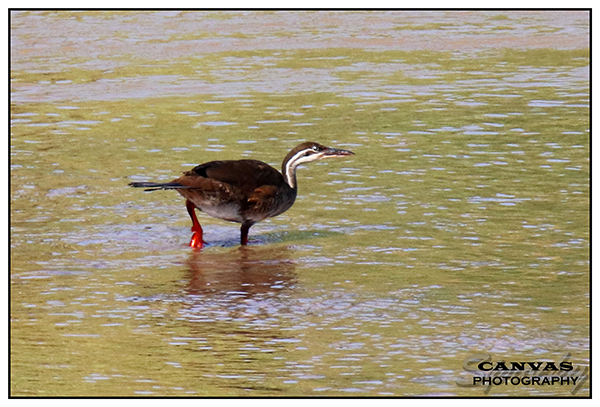 © Sprocky
© Sprocky
Grietjie Private Reserve
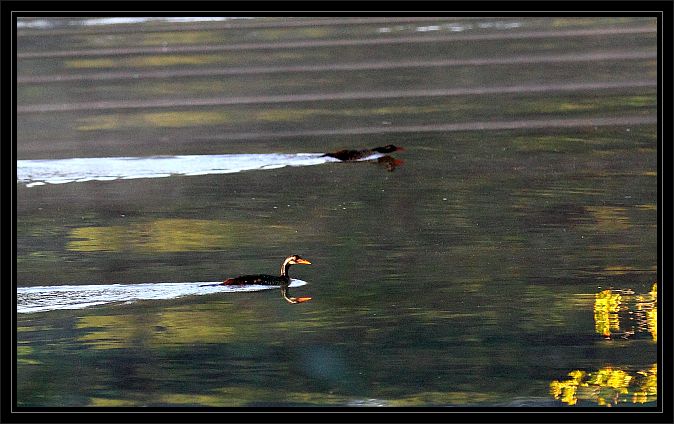 © Duke
© Duke
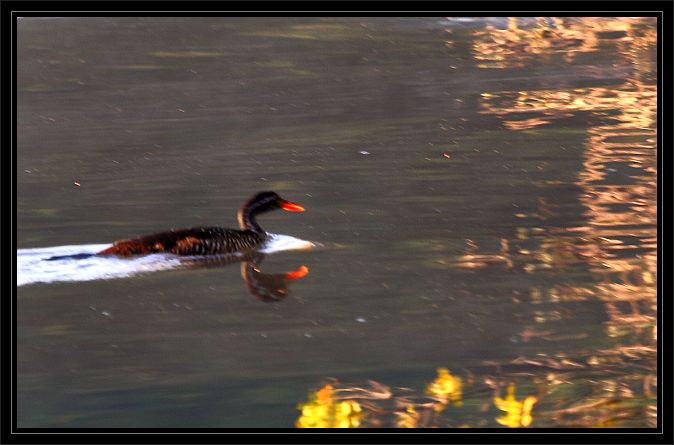
Links:
Species text in The Atlas of Southern African Birds
Sabap2: http://sabap2.adu.org.za/spp_summary.ph ... §ion=3
SASOL VOELS VAN SUIDER AFRICA (3de UIT)
BirdForum: http://www.birdforum.net/opus/African_Finfoot
Wikipedia: http://en.wikipedia.org/wiki/African_Finfoot
Biodiversity Explorer: http://www.biodiversityexplorer.org/bir ... lensis.htm
BirdLife South Africa: Kruger to Canyons Birding Route
Grietjie Private Reserve
 © Duke
© Duke
Links:
Species text in The Atlas of Southern African Birds
Sabap2: http://sabap2.adu.org.za/spp_summary.ph ... §ion=3
SASOL VOELS VAN SUIDER AFRICA (3de UIT)
BirdForum: http://www.birdforum.net/opus/African_Finfoot
Wikipedia: http://en.wikipedia.org/wiki/African_Finfoot
Biodiversity Explorer: http://www.biodiversityexplorer.org/bir ... lensis.htm
BirdLife South Africa: Kruger to Canyons Birding Route
Family Sarothuridae (Flufftails)
Family Sarothruridae (Flufftails)
The flufftails are placed in the family Sarothruridae, small birds related to the rails. The family is restricted to seven species distributed across sub-Saharan Africa, and two species found in Madagascar. The group's common name is derived from the short tail which has degraded fluffy feathers. All species except the White-winged Flufftail display sexual dimorphism in their plumage but not their size.
Flufftails are highly secretive and seldom observed. Two species, the Buff-spotted Flufftail and the White-spotted Flufftail, are inhabitants of dense forests, the remaining species are found in deep grasslands and marshes. One species, Streaky-breasted Flufftail, is known to be migratory, it is uncertain whether other species are as well; the White-winged Flufftail may breed in Ethiopia and winter in South Africa but this is not known for certain.
The breeding behaviour of the flufftails has not been observed for many species. Many species breed in the wet season. All species are highly vocal during the breeding season, with repertoires including duets. In the Madagascar Flufftail the courtship behaviour consists of duetting, nest building, which is undertaken by the male, nest visits by the female and copulation. The nests are domed, and in the Madagascar Flufftail it is positioned high above the ground in vines, in the White-winged Flufftail the nest is in reeds over waterlogged ground. The eggs of all the species that have been studied are white, which is unusual for rails. The chicks are covered in black down at birth and have a slightly coloured bill; adult plumage is quickly attained in most species. Both parents care for the chicks.
Two species are currently considered endangered by the IUCN, the White-winged Flufftail and the Slender-billed Flufftail. They are threatened with habitat loss caused by the draining of wetlands for cultivation.
The flufftails are placed in the family Sarothruridae, small birds related to the rails. The family is restricted to seven species distributed across sub-Saharan Africa, and two species found in Madagascar. The group's common name is derived from the short tail which has degraded fluffy feathers. All species except the White-winged Flufftail display sexual dimorphism in their plumage but not their size.
Flufftails are highly secretive and seldom observed. Two species, the Buff-spotted Flufftail and the White-spotted Flufftail, are inhabitants of dense forests, the remaining species are found in deep grasslands and marshes. One species, Streaky-breasted Flufftail, is known to be migratory, it is uncertain whether other species are as well; the White-winged Flufftail may breed in Ethiopia and winter in South Africa but this is not known for certain.
The breeding behaviour of the flufftails has not been observed for many species. Many species breed in the wet season. All species are highly vocal during the breeding season, with repertoires including duets. In the Madagascar Flufftail the courtship behaviour consists of duetting, nest building, which is undertaken by the male, nest visits by the female and copulation. The nests are domed, and in the Madagascar Flufftail it is positioned high above the ground in vines, in the White-winged Flufftail the nest is in reeds over waterlogged ground. The eggs of all the species that have been studied are white, which is unusual for rails. The chicks are covered in black down at birth and have a slightly coloured bill; adult plumage is quickly attained in most species. Both parents care for the chicks.
Two species are currently considered endangered by the IUCN, the White-winged Flufftail and the Slender-billed Flufftail. They are threatened with habitat loss caused by the draining of wetlands for cultivation.
Family Sarothuridae (Flufftails) Index
Species indigenous to southern Africa:
Family Sarothruridae (Flufftails)
Sarothrura pulchra White-spotted Flufftail
Sarothrura elegans Buff-spotted Flufftail 218
Sarothrura rufa Red-chested Flufftail 217
Sarothrura lugens Chestnut-headed Flufftail
Sarothrura boehmi Streaky-breasted Flufftail 219
Sarothrura affinis Striped Flufftail 221
Family Sarothruridae (Flufftails)
Sarothrura pulchra White-spotted Flufftail
Sarothrura elegans Buff-spotted Flufftail 218
Sarothrura rufa Red-chested Flufftail 217
Sarothrura lugens Chestnut-headed Flufftail
Sarothrura boehmi Streaky-breasted Flufftail 219
Sarothrura affinis Striped Flufftail 221
Last edited by Falanajerido on Sat May 03, 2014 12:40 pm, edited 1 time in total.


